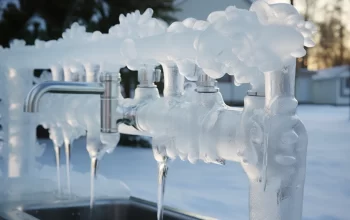Home plumbing pipes come in many varieties; you have options such as copper piping (rigid or flexible), plastic PEX pipes and even old-school galvanized steel and cast iron pipes which were once popularly used.
Your choice of pipe for your plumbing system can have a dramatic impact on its performance and help avoid expensive repairs. Here are some helpful guidelines that will assist in selecting suitable piping material for your project.
Copper
Copper pipes are an economical, energy-saving choice for water supply lines in your home, without posing health risks or being difficult for plumbers to work with. Copper is also highly durable and capable of withstanding extreme temperatures without succumbing to cracking.
Rigid copper, known for its distinctive reddish-brown hue, is often utilized in residential water supply lines. Due to its dense structure and resistance against bacteria infiltration, rigid copper offers effective protection from outside contaminants such as petroleum products on local streets or insecticides and fertilizers used on yards.
Copper drain, waste, and vent (DWV) pipes feature distinctive yellow markings to indicate their purpose as drain pipes to carry waste water away from homes and into city sewage systems; however, they can also be used with hot water heaters and gas lines (where permitted). Plumbers commonly employ copper DWV when repairing or extending interior branch water pipes.
PEX
PEX pipes have become an increasingly popular choice for residential plumbing applications due to their easy installation and many advantages over alternative materials.
PEX pipe is durable and resistant to corrosion that could otherwise lead to leaks in metal pipes, while being insulated and sound-absorbing to help minimize noise from running water – providing homeowners with an added bonus as they enjoy music or movies without hearing running water disrupt their listening or viewing pleasure.
PEX pipes make connecting easier than ever, as they connect using compression fittings – much quicker and simpler than working with copper pipes that require soldering! This can save both time and money for homeowners.
In regions with cold weather, it’s essential to select plumbing pipe material capable of withstanding freezing temperatures. Frozen pipes can quickly create havoc that requires costly repairs; PEX pipes have the unique capability of expanding when they freeze to help prevent burst pipes from occurring.
PEX pipes are extremely flexible, making them easy to bend around corners in a home’s plumbing system. This makes PEX superior to PVC or copper in this regard; both require elbow fittings in these situations. However, PEX only can take limited bending before starting to kink; thus to prevent this happening it may be beneficial to install PEX bend supports near sharp corners for added support.
PVC
Your choice of pipes for a plumbing project has an effect on its lifespan and strength, so always consult a certified plumber before making your final decision if you plan to work on an older or unfinished part of your home.
Copper and CPVC pipes are among the most commonly used plumbing pipes, though other residential options such as galvanized steel and cast iron pipes also exist. Each option offers distinct benefits: galvanized and cast iron pipes are thick, sturdy and wide for easy flow; while copper pipes last long-term without leaching chemicals into your water.
Cross-linked polyethylene (PEX) pipes have become increasingly popular due to their versatility and ease of installation. PEX pipes can easily bend around obstacles for retrofitting projects or remodeling endeavors; their durable composition protects against freezing and corrosion damage – unlike rigid copper, PEX does not pose health risks when used for drinking water consumption.




